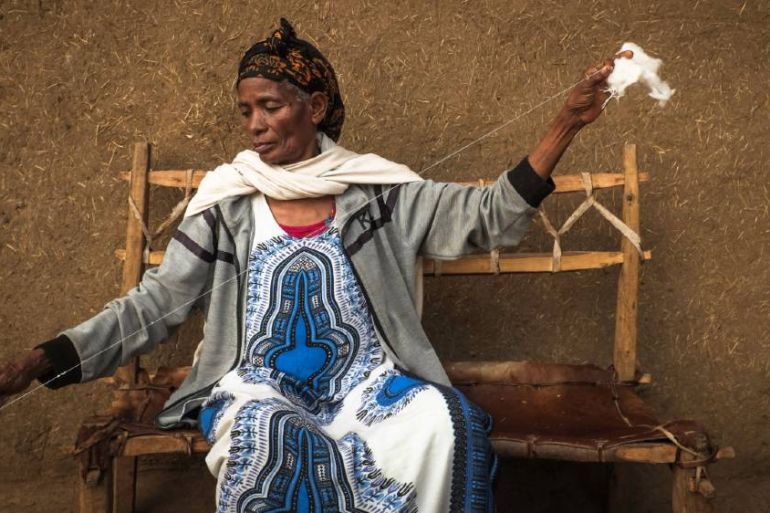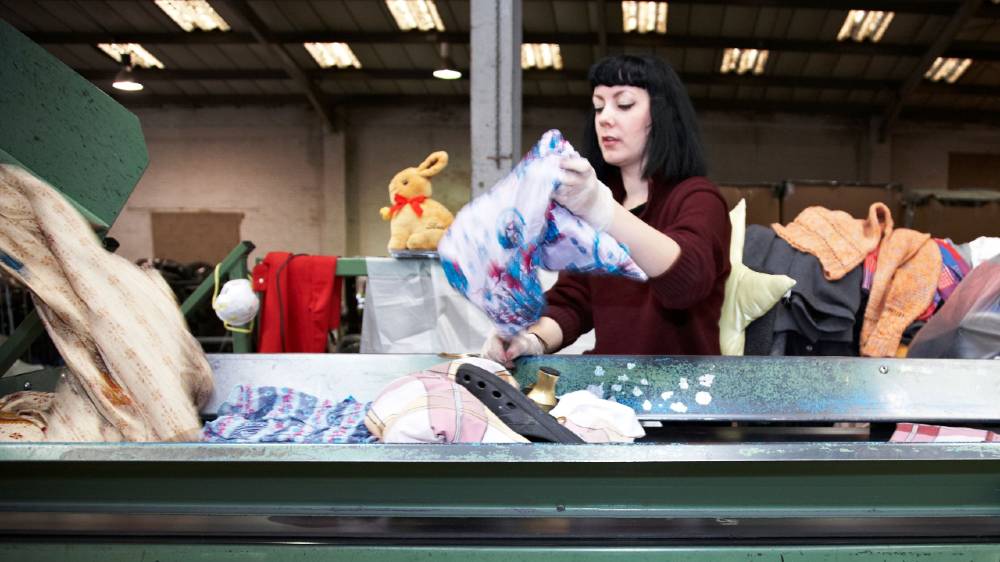Fashion turns to technology to tailor sustainable solutions
At the cutting edge of fashion and science, innovators are setting a new trend with a circular model of consumption.

Paris, France – Highlighting the growth of fast fashion – at least in the form of increasing volumes of cheap and disposable clothing – TRAID’s warehouse in London was receiving around 3,000 tonnes of donated clothes every year before coronavirus hit.
“We’re sorting through more volume and finding less that can go into our shops than a few years ago,” said Leigh McAlea, head of communications at TRAID, the United Kingdom-based clothes charity that aims to reduce the environmental and social impact of the fashion industry by encouraging people to shop second-hand.
Keep reading
list of 3 itemsA Hard Road from Home: Music and Fashion
Fairy Tales: The Fashion Misfit of China
“We’re seeing a lot of fast fashion items, a lot of clothes that have been barely worn or still have tags on. Items that go into our 12 charity shops have to be good enough quality to resell, whether they’re Primark or Prada. We want to encourage people to buy better quality and then donate items when they have finished with them,” McAlea told Al Jazeera.
But waste is a problem throughout the fashion supply chain, with significant numbers of garments never even making it to the shop floor. It’s an issue that has been brought into even sharper focus by the coronavirus pandemic.
According to the Bangladesh Garment Manufacturers and Exporters Assocation, the COVID-19 crisis has already led to the suspension or cancellation of orders for 982 million items of clothing, worth an estimated $3.18bn.
The crisis highlights the need for solutions to unwanted textiles, whether new or worn.
|
|
“We have been collecting Hong Kong’s unwanted clothing for the past eight years, and we’re now redistributing to around 20 charities,” said Hannah Lane, director of partnerships and communications at Redress, a Hong Kong-based sustainable fashion NGO.
“We regularly receive garments that are in poor condition because of their low quality. Around 15 percent of what we collect cannot be reused, and mostly has to be downcycled into an item of lower quality – or sent to landfill.”
Green is the new black
Fast fashion is on the rise – according to McKinsey & Company research cited by Greenpeace, the average global consumer now buys 60 percent more clothes per year and keeps them for half as long as they did 15 years ago – and a ready supply of cheap garments is driving a culture of overconsumption, with catastrophic results for the planet. Fashion is responsible for around 1.2 billion tonnes of carbon emissions globally every year, and United Nations climate change statistics predict a more than 60 percent increase in textile and apparel production emissions by 2030.
The coronavirus crisis is calling into question many aspects of consumer behaviour, and there are hopes that it could have an impact on shoppers’ demand for fast fashion.
Even before it hit, flagship initiatives by big players such as H&M, which has pledged to use 100 percent recycled or sustainably sourced materials by 2030, are a sign that the fast fashion business is serious about getting greener, but experts say the industry needs to make the shift from a linear to a circular model.
“Our planet can hardly support our current consumption of raw materials, let alone in 2050 when we will be approximately nine billion people,” Joost van Dun, head of circular economy at Netherlands-based bank ING, told Al Jazeera.
“We need to rethink how we make and consume our products, making the shift from the linear economy where products are disposed of after use, to a circular economy – where we focus on keeping products and materials in the loop as much as possible.”

Consumers are getting on board – a global survey of 15,000 people commissioned by ING and released in February showed 61 percent of consumers would be less willing to buy a company’s product if they discovered it was performing poorly on environmental practices.
“In one way, the fashion industry is in contradiction with fully sustainable business,” said van Dun, “but we can improve the supply chain, production, how we work with materials and how we reuse or recycle them.”
The small steps being taken now are set to get bigger, he believes. “I’m happy with what we’ve seen among the consumers we’ve surveyed, that brands have to take action because consumers demand it.”
|
|
The cutting edge
Pre-pandemic, the fashion industry’s overall waste was predicted to increase by around 62 percent from 2015 levels, reaching an annual total of 148 million tonnes by 2030, according to a 2017 Pulse of the Fashion Industry report by the Boston Consulting Group and Global Fashion Agenda.
To reduce fashion’s impact, whether at the design or manufacturing stage, during the distribution process or once clothes have been worn, new and fast-evolving technologies have a crucial role to play.
French startup Heuritech’s artificial intelligence-powered trend-forecasting platform teaches algorithms to analyse images from Instagram and Weibo, recognising product details to predict product trends.
Brands including Adidas, Lee, Wrangler and Havaianas subscribe to Heuritech’s platform to help them accurately tailor their production to future demand, cutting waste.
The technology can recognise more than 2,000 details such as colour, texture, print, neckline or sleeve shape, extracting data and using algorithms to predict trends, explains chief marketing officer Celia Poncelin.
Heuritech does not release sales or profit figures, but has raised more than five million euros ($5.45m) in funding over six years, and has 50 employees across three offices in Paris, New York and Singapore.
|
|
The company has adapted to the post-COVID era, with its latest report in May forecasting post-lockdown trends in China, including warm colours, logos and fluorescence to express post-confinement joy.
A new trend
Once the design process gets underway, digital sampling can help reduce waste, as Hong Kong-based garment manufacturer TAL Apparel, which has 11 clothing factories across Asia, can attest.
Traditional manufacturing methods might see one garment sampled 20 times or more, but digital samples are so lifelike and accurate that they can eliminate the need for a physical sample completely. For a company such as TAL – producing one in every six dress shirts sold in the US market each year – the potential savings in fabric, energy and water are enormous.
“Digital sampling has the potential to make significant reductions on fabric wastage across the industry. If our clients alone all switched to this new technology, we would see savings of over 300,000 yards a year,” said Roger Lee, CEO of the TAL Group.
Initiatives by mass manufacturers such as TAL are vital, says Christina Dean, founder of Redress, whose Redress Design Award aims to raise awareness of sustainability among a new generation of young designers. “We have to scale sustainable solutions into the mass manufacturing world, we can’t just keep ideas at a very small level.”

There is also potential to cut emissions by dealing more efficiently with the distribution and returns processes of fashion and by getting more use out of second-hand garments.
Software specialist Optoro gives retailers better visibility on returns in an attempt to divert them from landfill to donation, resale or recycling.
|
|
In 2004, Optoro co-founder and CEO Tobin Moore started a business in Washington, DC in the United States, helping people list goods on eBay. He and co-founder Adam Vitarello noticed that many small businesses had piles of returned and excess inventory gathering dust in back rooms.
They set out to tackle this, and four years later, Optoro launched as a technology company, using cloud-based software, data and machine learning to make the returns process more efficient and keep returned goods out of landfill, using an algorithm to divert them instead to the most profitable next destination – back to stock, for refurbishment, for a secondary marketplace or for charitable donation.
The company says it has so far diverted 3.9 million lbs (1,770 tonnes) of waste from landfill and prevented 22.7 million lbs (10,300 tonnes) of carbon emissions, as well as facilitating the donation of 2.7 million items to charities.
“Returns produce five billion pounds of waste every year in the US alone. With the growth of e-commerce and a cultural shift towards sustainability, retailers and brands are beginning to pay more attention,” said Larisa Summers, the firm’s senior vice president of e-commerce and digital marketing.
In 2019, on average, Optoro clients – which it lists as including Target, Under Armour and BJs – were able to keep 96 percent of returned and excess goods out of landfill through its returns technology, with a 30 percent reduction in cost on average.
Thinking caps on
The coronavirus crisis makes effective supply chain management even more important for retailers, which are having to adapt to changes such as the closure of brick-and-mortar stores and new requirements for working conditions for staff.
|
|
“The effects of COVID-19 are forcing retailers to reconsider their current facility capabilities and get creative on how to tackle issues of fulfillment capacity, trapped inventory and safety,” Moore wrote in an April 30 blog post. “As a result, we’re seeing retailers turn to technology solutions and outsourcing opportunities as a way to ramp operations and solve for immediate capacity. However, this pandemic has been a forcing function for retail in general to revisit current operations and prioritise improvements for future profitability.”
James Reinhart, co-founder and CEO of thredUP, saw the untapped potential in the fast-growing second-hand clothing market when he tried to get rid of some unwanted clothes – and was told the thrift shop couldn’t accept the everyday brands he was selling. A decade later, he runs the world’s largest online apparel resale marketplace.
In the early days, thredUP, which uses vast quantities of data to make shopping second-hand easier, used iPhones to photograph the items sent in. Now its human staff are aided by machine learning, with a redistribution system designed by former SpaceX and Netflix engineers. The company has upcycled 100 million items, saving the equivalent of 870,000 tonnes of CO2 emissions.
The challenge is to change the way we produce, use, collect and recycle this valuable resource, ensuring it remains in continual circulation and out of landfill and incineration.
Israeli tech startup SMX is another company using innovation to pioneer advances in sustainable fashion. It uses blockchain technology through a partnership with software company R3 to improve supply chain transparency, placing a chemical marker into the molecular matter of raw materials before they are transformed into textiles – and using blockchain technology to store the supply chain history.
This access to accurate information about textiles increases the likelihood of their being recycled after use.
“Most of the materials today related to fashion and plastic can be reused and recycled not more than three times. The problem is that they’re not marked and tracked in a way that sustains the recycling process,” says SMX CEO Haggai Alon.
|
|
“One of the things that SMX can do is to solve the sorting issue, and the recycling issue. Our technology doesn’t solve all the issues, but creates links between different players from upstream and downstream of the value chain.”
ING’s van Dun agrees: “Blockchain technology is key in making the supply chain more transparent – this is a really important technology.”
The race to recycle
For those garments that don’t make the grade for reselling, environmentally friendly recycling solutions are improving too, explains Chiara Galimberti, business development director at Worn Again Technologies, the company behind a new pilot R&D facility in Redcar, England, which aims to keep more existing textiles in circulation – and out of landfill.
The company’s recycling process is able to separate, decontaminate and extract polyester and cellulose from cotton and non-reusable textiles, as well as polyester bottles and packaging to be made back into new products in existing supply chains.
Current textile-to-textile recycling methods are unable to separate out dyes and other contaminants, or to separate mixed fibres, such as polyester and cotton blends, Worn Again says. This means less than one percent of existing textiles go back into the making of new textiles, while an estimated 53 million tonnes of textiles go to landfill or incineration every year worldwide.
“We currently have enough textiles in circulation today to satisfy today’s annual demand,” said Galimberti.
“The challenge is to change the way we produce, use, collect and recycle this valuable resource, ensuring it remains in continual circulation and out of landfill and incineration.”